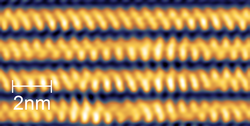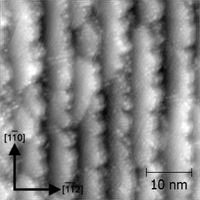Quasi one-dimensional atomic wires
Ideal one-dimensional (1D) electronic systems have peculiar properties, such as quantization of conductance, charge-density waves (CDWs), and Luttinger-liquid behavior, a variety of instabilities with a wealth of associated phase transitions. These are due to their reduced dimensionality and the concomitant high electronic correlations. However, systems that are experimentally realized are inevitably coupled in two (2D) or three (3D) dimensions. Thus their properties are stabilized at higher temperatures, but on the other hand, the 1D properties may be modified or even destroyed. Therefore, the central interest is the exploration and identification of physical scenarios with one-dimensional properties under explicit consideration of 2D and 3D coupling, their control and their manipulation. This highly interesting field is still largely unexplored both from the experimental and the theoretical side.
Metallic nanowires are prototype 1D systems. We concentrate on these systems, and explicitly consider them on well defined Si and Ge surfaces with cross-sectional widths of only a few atomic lattice constants. They are grown by self-assembly with noble metals such as Pt and Au as well as Pb, In and with silicides of rare earth elements and transition metals. Using both high symmetry planes and appropriate vicinal surfaces the intriguing question of coupling between wires, coupling to the underlying substrate and to the 3D embedding material are investigated systematically. Also the consequences of these interactions with respect to intrinsic instabilities (e.g. formation of charge density waves) and potential functionalities are explored. The investigations comprise both studies of ground state as well as of excited state properties in order to get information about electron-electron and electron-phonon coupling. Therefore, measurements of the structure and phase transitions in the wires and their electronic structure as a function of temperature and of wire density are combined with electronic transport, single particle and collective (plasmonic) excitations as well as with their dynamics.
In order to explore this field with its great variety of physical phenomena successfully and in reasonable depth, a collaboration FOR1700 between experimental and theoretical groups has been established to achieve the combination of various experimental and theoretical methods applied to identical systems.






Metallic nanowires on the atomic scale: Electronic and vibrational coupling in real world systems
Webseite:
www.atomicwires.de
Selected publications :
C. Brand, H. Pfnür, G. Landolt, S. Muff, J.H. Dil, T. Das, C. Tegenkamp (2015): Observation of correlated spin-orbit order in a strongly anisotropic quantum wire system, Nature Communications 6, Article number: 8118 (2015)
DOI: 10.1038/ncomms9118
arXiv: 1507.06152
T. Lichtenstein, H. Teiken, H. Pfnür, J. Wollschläger, and C. Tegenkamp (2015): Au-chains grown on Ge(100): a detailed SPA-LEED study, Surface Science 632, 64 (2015)
DOI: 10.1016/j.susc.2014.09.002
U. Krieg, Yu Zhang, C. Tegenkamp, H. Pfnür (2014): Tuning of one-dimensional plasmons by Ag-Doping in Ag-√3-ordered atomic wires, New J. Phys. 16, 043007 (2014)
DOI: 10.1088/1367-2630/16/4/043007
